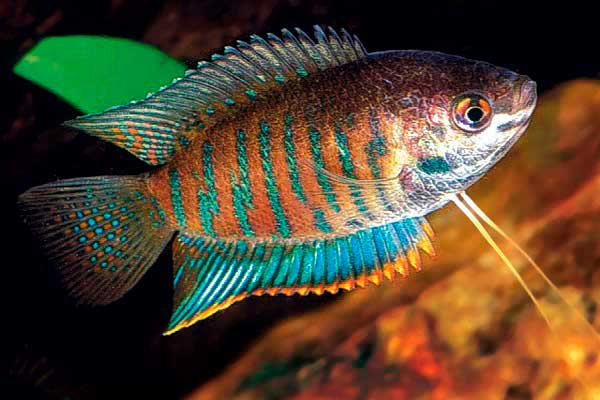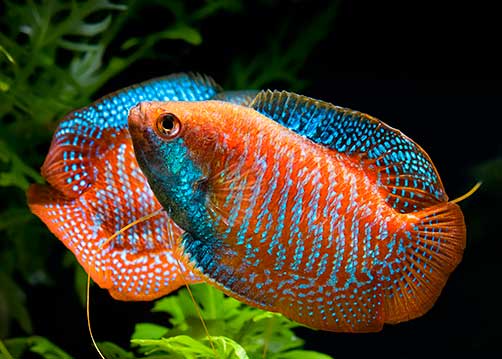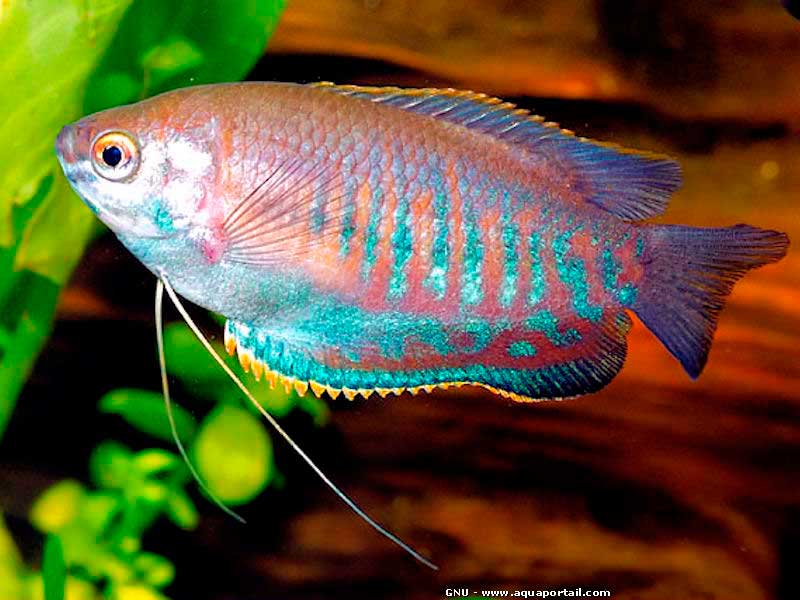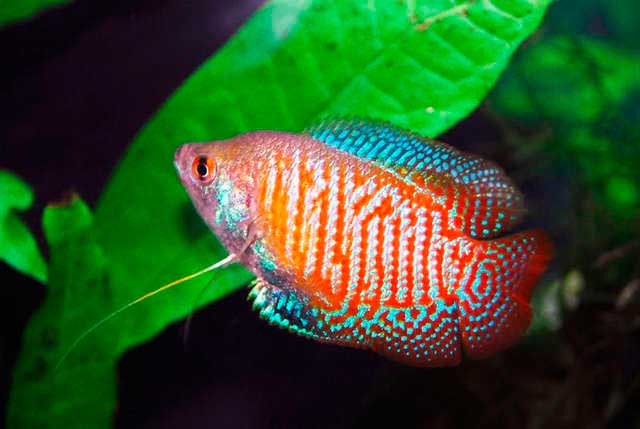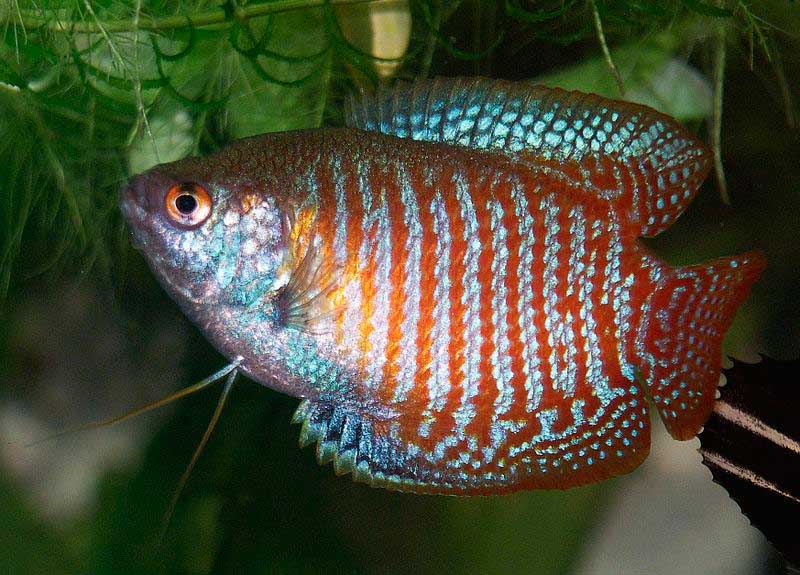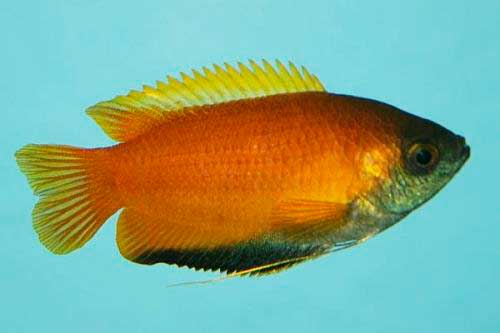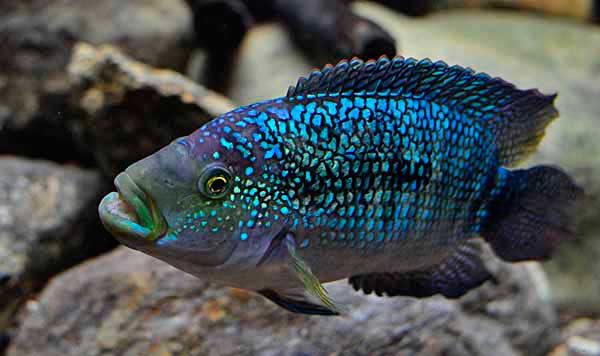The striped coliza is a very beautiful fish, having a similar coloration to that of the lalius, but its size is much larger. Therefore, the impression it makes is much greater. The species was first described in 1801 by Bloch and Schneider. European aquarists recognized this fish in 1897. In Russia, it appeared for the first time in 1904.
- Domain: Eukaryotes
- kingdom: Animals
- Type: Chordates
- Class: Radial fish
- Squad: Perch
- Family: Macropods
- Rod: Coliseums
- View: Striped coliza (Colisa fasciata)
The homeland of the striped coliseum is Thailand, Malaysia, Burma, and India.
Its size, as already mentioned, is larger than other representatives of the genus. In the wild it reaches twelve centimeters in length. Behind the glass of the aquarium it can reach ten centimeters. The body is flattened from the sides, relatively high. Its body is decorated with alternating transverse stripes of blue and orange color. The basic tone of the body is blue. Unpaired fins have red mottling and blue edging.
Its size, as already mentioned, is larger than other representatives of the genus. In the wild it reaches twelve centimeters in length. Behind the glass of the aquarium it can reach ten centimeters. The body is flattened from the sides, relatively high. Its body is decorated with alternating transverse stripes of blue and orange color. The basic tone of the body is blue. Unpaired fins have red mottling and blue edging.
Striped coliza aquarium maintenance
Content striped coliza is not difficult. For a pair of adult fish is sufficient aquarium volume of about 30 liters. The soil can be almost any of the long-established. Suitable coarse river sand, small pebbles, small gravel. It is also possible to use decorative soils.
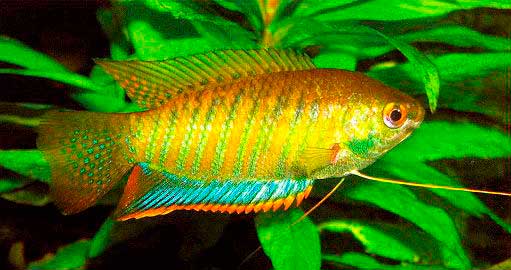
Any vegetation with suitable maintenance conditions. It is desirable at the side and rear windows to organize a small thicket of them. You can use for landscaping aquariums with striped coliforms cattail, vallisneria, elodea ferns, cryptocoryne.
Lighting is preferably bright. It is necessary that several hours a day the aquarium is illuminated by sunlight. But on the window sill aquarium should not be put. Since this place is subject to the greatest temperature fluctuations, and the fish do not like it.
Water parameters
The water should have a temperature of about 26 degrees Celsius. Hardness is not important, acidity should be neutral. In general, you can take ordinary water from the water supply, stand it for a day to get rid of chlorine, heated to the right temperature and that’s it. No other water treatment is required.
It is desirable to cover the aquarium from above with glass. Striped coliza – labyrinth fish and uses atmospheric air for respiration, so it is not desirable that above the surface of the water accumulated cold air. Swallowing it fish can get sick. Glass, which covers the aquarium, prevents the rapid entry of cold air into the above-water space.
What kind of food does the striped coliseum prefer?
You can feed the striped coliseum with any feed. But preference should be given to live feeds of suitable sizes. Their favorite feeds in our latitudes can be small artemia, daphnia, small moths, cut tubeworms and even small uncut earthworms.
Particularly good conditions must be created for the fish if you want to breed them. Future producers should try to feed exclusively live variety of food. In this case, you should remember about the harm of inbreeding, and if you decide to engage in breeding these beautiful fish, you should try to take females from one fish farm, and males from another.
The fact is that the striped coliza has been imported to Russia many times. But, unfortunately, its magnificent coloration in a few generations in our aquariums is lost. Why does this happen? Give a definite answer is difficult. Most likely, it is a combination of several factors. Accelerate the degeneration of species can and poor nutrition and close inbreeding, and in the case of representatives of the genus Koliza is possible and lack of solar insolation. Maybe it is you who can answer these questions 😉
Striped coliza Spawning in the aquarium
It is better to plan spawning in spring time, when there will be no problems with the extraction of small food in natural water bodies. For reproduction, it is better to organize a separate spawning ground. For spawning is suitable aquarium for 25 – 30 liters.
One of the corners of the aquarium should be densely planted with plants, thus forming a man-made thicket. On the surface of the water you can throw a bunch of riccia or cassava. Literary data indicate that striped coliza is not demanding to the hardness of water. But still for spawning aquarium I would advise to soften the water somewhat, replacing about half of the volume of boiled cooled water.
When the male finds the conditions suitable, he will begin to build a foam nest. When the nest is ready, spawning will take place. Immediately after this, it is desirable to remove the female and leave the eggs in the care of the male.
Caring for fry
And when the fry will swim, then it is necessary to withdraw and the male. Now all the worries of feeding the fry fall on you. This will happen about 5-6 days after spawning. Feed in the first two weeks you can and home culture of infusoria, but it is better to try to catch in the nearest natural freshwater living dust, rotifers, cyclops. As the growth of fry should be sorted by size and transferred to larger types of food.
This is such an interesting striped coliseum. I would call it a big lalius 🙂 . If you are lucky enough to get these beauties, I think you will not be disappointed. After all, for their behavior can be observed for hours, and bright coloration in combination with large size will give fororah many species that appeared in the aquariums of amateurs much later than 1904.
